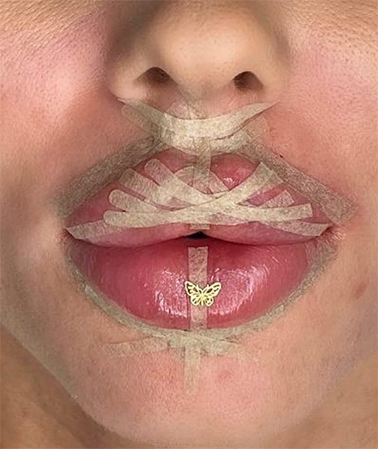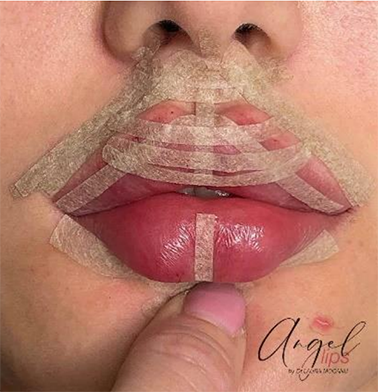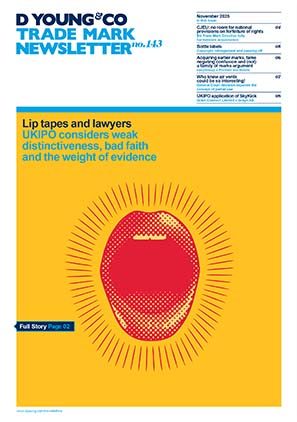Lip tapes and lawyers: UKIPO considers weak distinctiveness, bad faith and the weight of evidence
Two recent UKIPO opposition decisions demonstrate the pitfalls and evidential hurdles when relying on marks with low distinctive character and the impact of correspondence between parties when pleading bad faith. The contrasting outcomes highlight the importance of preparing a clear strategy, persuasive evidence and proper pleadings.
Cases discussed
Thelawyer.com Limited v Legaltech ApS (O/0844/25) (Thelawyer.com) and Laura Mocanu v Joanna Komisarczyk (O/0857/25) (Mocanu).
Distinctiveness
In Thelawyer.com, the applicant applied to register “The Lawyer Hub” in classes 35, 36, 41, and 42. The opponent relied on two earlier “The Lawyer” marks in classes 9, 16, 35, 38, and 41.
The hearing officer found the goods and services to range from identical to dissimilar. the marks in contention were held to be visually, aurally and conceptually similar to a medium degree.
The distinctiveness of the earlier marks was central to the hearing officer’s decision. The applicant argued that the earlier marks lacked distinctive character, and while it was not open to the hearing officer to deem registered marks as descriptive or non-distinctive, she accepted that “THE LAWYER” may possess limited distinctiveness for some goods and services within the legal sector. Nevertheless, she maintained that this assessment could vary, noting that consumers might still perceive the earlier marks as distinctive, even if they remain inherently weak.
Following a detailed review of the opponent’s evidence, the hearing officer found enhanced distinctiveness for certain class 41 services among legal professionals, though not more widely. Low distinctiveness was found in relation to all other goods and services relied upon.
It followed that, in evaluating the opponent’s claims of confusion, reputation and passing off, the hearing officer was prepared to find in the opponent’s favour only in respect of those services benefiting from enhanced distinctiveness namely, “news reporters services; publishing, reporting, and writing of texts” in class 41. The opposition failed in relation to the remaining contested services. Had the hearing officer been unwilling to recognise enhanced distinctiveness, albeit for a limited range of services, the opposition based on earlier rights would have failed entirely.
The Mocanu case concerned the comparison of figurative marks showing a lip taping technique. On first impression, the marks appeared to be visually similar and the services were identical, both covering beauty care and treatment services for the lips in class 44.



However, the confusion claim was unsuccessful as the opponent’s marks were only distinctive to a very low degree. The overlapping elements, namely the image of human lips taped with strips, which feature in the application and opponent’s marks, were descriptive of the relevant services. When the marks at issue overlap in descriptive or non-distinctive elements, the distinguishing features will become more significant and carry more weight in the comparison. Even though such elements were comparatively smaller or had less visual impact, the hearing officer noted that the wording in the corner, gold butterfly and the exact placement of tape in the opponent’s marks were not replicated in the application.
Bad faith
In Thelawyer.com the opponent submitted correspondence between the parties as evidence of its bad faith claim. Whilst the applicant contested the admission of this correspondence due to its “without prejudice” nature, during a hearing earlier in proceedings the hearing officer decided that the material was not without prejudice and therefore admissible. The applicant’s request for permission to appeal this procedural decision was refused.
Admission of this correspondence led to a finding of bad faith because the applicant stated that its intended use of “the lawyer hub” mark was to redirect consumers to its website named “the attorney hub”; thus, the application was filed primarily as a defensive measure. It was alleged that the applicant therefore admitted the application was filed as a defensive measure and a blocking mechanism rather than to put the mark to use, amounting to bad faith.
The hearing officer agreed that the application was filed not for genuine trade mark use but to secure exclusivity and extend any legitimately held protection over “The Attorney Hub.” Its intended use, to capture and redirect consumers to another website, did not constitute trade mark use. Accordingly, the applicant failed to rebut the prima facie finding of bad faith, and the application was refused in full.
In Mocanu, the applicant had attended the opponent’s masterclass on lip taping in November 2022, prior to the relevant trade marks being filed. As part of the course, the applicant signed an agreement not to use the opponent’s marks without consent or use images of the opponent’s technique without using the opponent’s trade mark “LORÁN lips”. A few months later, the opponent applied for the figurative marks relied upon in the opposition, and sent a text message informing the applicant that they had registered figurative trade marks and that, as a result, the applicant would now need a licence to use images of the technique. The applicant pushed back on this, noting that this was not in the agreement, which was signed before the trade marks were applied for.
The opponent relied on the applicant’s knowledge of the opponent’s marks, in combination with a breach of the agreement, to argue that the applicant’s intention when filing the application was to cause confusion and damage the opponent’s reputation. The applicant countered by arguing that the application depicts a different and novel technique, based on personal experience and attendance of more than 50 medical and aesthetic courses.
Ultimately, the hearing officer sided with the applicant, noting that mere knowledge of another party’s use of a mark is not sufficient, in isolation, to establish bad faith. The hearing officer conceded that use of Dr Mocanu’s “LORÁN Lips” technique without crediting the opponent would be a breach of the agreement but noted that:
- any reference to the trademarked techniques within the agreement does not cover the marks relied on in the opposition (which were filed later); and
- the application is not an image of Dr Mocanu’s technique, due to the differing placement of the tapes.
Further, the application shows the result of a technique, not a technique itself (which cannot be protected under trade mark law).
This case shows the importance of proper pleading for bad faith claims; it is a serious allegation and the burden is on the opponent.
Key takeaways
A key takeaway from both cases is the challenge faced by proprietors relying on marks with low inherent distinctiveness. Even though marks can be considered similar or an earlier mark has demonstrable reputation, if the mark relied upon possesses low inherent-distinctiveness, enforcement becomes significantly harder. As shown in Mocanu, minor differences between marks can extinguish a confusion claim and this is a core issue with obtaining registration for “borderline” trade marks which only just get over the distinctiveness line. In such cases, it is crucial to develop a robust body of persuasive evidence capable of supporting an enhanced distinctiveness claim in order to elevate the overall distinctiveness of the mark and assist with enforcement.
As shown in the contrasting outcomes of these cases, such evidence can make or break a confusion claim.
Treatment of pre-action correspondence is also highlighted in Thelawyer.com. Despite the applicant’s claims that the communications were “without prejudice” and therefore inadmissible, the correspondence was admitted into proceedings as evidence, demonstrating how critical it is to clearly and appropriately label communications. This serves as a stark reminder that missteps in this respect can have significant consequences for a party’s position in opposition proceedings. Had the correspondence been deemed “without prejudice”, the opponent’s bad faith claim would likely have failed.
Correspondence between the parties was also relevant in Mocanu, highlighting the importance of drafting clear agreements which incorporate all relevant trade marks, but it is also a reminder that mere knowledge of another party’s mark is not sufficient to successfully plead bad faith.
Case details at a glance
Jurisdiction: England & Wales
Decision level: UKIPO
Parties: Thelawyer.com Limited v Legaltech ApS
Citation: O/0844/25
Date: 16 September 2025
Decision: dycip.com/ukipo-o-0844-25
Jurisdiction: England & Wales
Decision level: UKIPO
Parties: Laura Mocanu v Joanna Komisarczyk
Citation: O/0857/25
Date: 18 September 2025
Decision: dycip.com/ukipo-o-0857-25


